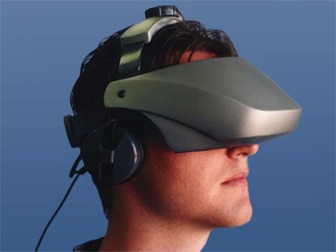VIRTUAL REALITY
WHAT IS VIRTUAL REALITY?

Name Virtual reality comes, naturally, from the definitions for both ‘virtual’ and ‘reality’. The definition of ‘virtual’ is near and reality is what we experience as human beings. So the term ‘virtual reality’ basically means ‘near-reality’. This could, of course, mean anything but it usually refers to a specific type of reality emulation. Virtual reality is an artificial environment that is created with software and presented to the user in such a way that the user suspends belief and accepts it as a realistic environment.
In technical definition, Virtual Reality (VR) is the computer-generated simulation of a three-dimensional image or environment that can be interacted with in a seemingly real or physical way by a person using special electronic equipment, such as a helmet with a screen inside or gloves fitted with sensors.
Virtual Reality refers to a high-end user interface that involves real-time simulation and interactions through multiple sensorial channels. Virtual Reality means feeling an imaginary (virtual) world, rather than the real one. The imaginary world is a simulation running on a computer. The sense data is fed by some system to our brain. It allows a user to interact with a computer-simulated environment, be it a real or imagined one.
HISTORY OF VIRTUAL REALITY?
- 1950’s visionary cinematographer Morton Heilig built a single user console called Sensorama. This enabled the user watch television in three-dimensional ways.
- In 1961, Philco Corporation engineers developed the first HMD known as the Headsight.
- It was in 1965 IVAN SUTHERLAND envisioned what he called the “UltimateDisplay.”
- In 1988, commercial development of VR began.
- In 1991, first commercial entertainment VR system "Virtuality" was released.

TYPES OF VIRTUAL REALITY
VR Systems can be divided into three groups:- Non-immersive systems (like workstations)
See information about the real world, presented via computer - location-based services, GIS. - Augmented reality systems (like Head Mounted Display)
Stay in the real world, but see simulated objects. - Immersive systems (like CAVE)
See the simulated world and "be" in that simulated world.

DEVICES USED IN VIRTUAL REALITY
| VR CONTROLLER | GAMEPAD |
|---|---|
 |  |
| HAND GLOVES | DATA SUIT |
|---|---|
 |  |
APPLICATIONS OF VIRTUAL REALITY
Business:
Virtual reality is being used in a number of ways by the business community which includes:- Virtual tours of a business environment.
- Training of new employees.
- A 360 view of a product.
Training:
- Virtual reality environments have been used for training simulators.
- Examples include flight simulators, battlefield simulators for soldiers, paratrooper.
Engineering and Design:
- VR is widely used in engineering and designing process.
- It gives a better understanding of the design and facilitates changes wherever necessary.
- It helps to reduce the time and cost factor.
- Examples: Building construction, car designing.

Medical:
- Healthcare is one of the biggest adopters of virtual reality which encompasses surgery simulation, phobia treatment, robotic surgery and skills training.
- VR finds its application in nursing, dentistry, health issues for the disabled.

Entertainment:
- The entertainment industry is one of the most enthusiastic advocates of virtual reality, most noticeably in games and virtual worlds.
- Virtual Museum, e.g. interactive exhibitions
- Gaming
- Virtual theme parks
CONCLUSION
| 1999 | 10% of the world's computing power was non-human. |
| 2029 | 99% of the world's computing capacity will be non-human. |
- Virtual Reality is a growing industry.
- PC and specialized hardware are getting better, faster and cheaper because of development in VR.
- In the past, computing power has doubled approximately every 18 months. If this is the case then we should have a computer powerful enough to run immersive VR programs in our own homes by the year 2037.
REFERENCES
- Evolution of Virtual Reality http://www.ec.njit.edu/~gdb1498/Portfolio/CIS350TermPaper2.html
- Evolution of Virtual Reality http://www.ec.njit.edu/~gdb1498/Portfolio/CIS350TermPaper2.html http://ei.cs.vt.edu/~history/Tate.VR.html>
- http://ei.cs.vt.edu/~history/Tate.VR.html>
- http://ei.cs.vt.edu/~history/Tate.VR.html>
- "virtual reality (VR)" Encyclopedia Britannica Online. 11 Dec. 2009 http://www.britannica.com/EBchecked/topic/630181/virtual-reality
- Strickland, Jonathan. "How Virtual Reality Works" Web. 9 Dec. 2009. http://electronics.howstuffworks.com/gadgets/other-gadgets/virtualreality8.htm#
Virtual Reality is the most haunted technology in this day and time. It is the future enhancement of the games industry. Very interesting, i have really enjoyed your site!
ReplyDeleteVirtual Reality App